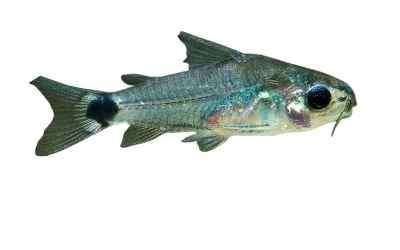The Dwarf Corydoras is a very well-known freshwater aquarium fish due to its body shape and attractive transparent coloration. It is a tropical freshwater fish which belongs to the family Callichthyidae (sub-family-Corydoradinae) under order Siluriformes of class Actinopterygii (=Osteichthyes). The dwarf corydoras (Corydoras hastatus) was first discovered by Carl H. Eigenmann ( a German-American Ichthyologist) and his spouse Rosa Smith Eigenmann in 1888.
Common Names
The Dwarf Corydoras has several common names including dwarf catfish, Mini spotlight corydoras, micro catfish, Pygmy corydoras, Tail spot pygmy catfish etc.
Distribution and Habitat
It is native to the Amazon and Paraguay River basins of Argentina, Bolivia and Brazil. It prefers to live in small rivers, swamps, pools and floodplains where large numbers of marginal vegetations for shelter are available.
Body Shape and Colors
The body is elongated with a forked caudal fin. It has an olive gray body color with a black spot at the base of the tail or caudal fin. Underside of the body and all fins are transparent in color. Eyes are relatively large and the body bears distinct lateral line that runs from the eye and ends at the base of the caudal fin.

Body Size and Lifespan
It can grow as much as four cm in length. Its life span ranges from 4 to 5 years or more if proper care is taken.
Quick Dwarf Corydoras Facts
- Scientific Name: Corydoras hastatus
- Origin: South America
- Grown-up size: 4 cm in length
- Temperament: Peaceful
- Tank Level: It prefers to stay middle position of the tank
- Minimum Tank Size: 10 gallons
- Diet: Omnivore
- Breeding: Egg layers
- Suitable water pH: 6.0 -8.0
- Suitable water hardness: 5-19 dGH
- Suitable water temperature: 68-82 degree F
- Water Movement: Moderate
- Lighting: Moderate to normal lighting
- Care level: Moderate
- Life span: 4-5 years or more
Feeding Behavior
The Dwarf Corydoras is omnivore and in nature, its food mainly consists of aquatic worms, insect and its larvae, copepods and aquatic plants. In aquarium condition, it takes most sinking foods like shrimp pellets, algae pellets and frozen foods. It also prefers freeze dried flake foods and catfish pellets. To keep your fish happy, feed should be given 2-3 times daily. Feed should be offered at night because it becomes more active during night.
Housing and Care Facts
This attractive fish requires at least 10 gallons tank with lots of floating plants for hiding places. The tank should have a good filtration system with moderate current and normal to dim lighting. The tank bottom should be covered with smooth gravel or sand substances. They prefer to live in suitable water condition. In this case, water pH should be 6.0–8.0 with a hardness of 5–19 dGH, and temperature range should be between 20–28 0C (68–82 0F). To keep your tank environment healthy 20-25% water should be replaced on a regular basis.
Tank-mates
Dwarf Corydoras is a community fish and it always prefers to form school with at least six or more individuals. It should not be housed with aggressive fish like cichlids. Suitable tank mates include Danios, Tetras and Rasboras.
Breeding Behavior
The Dwarf Corydoras is an egg layer and it can easily breed in aquarium condition with proper care. It prefers to breed in such a place where sand or gravel and soft leaved plants are available. The breeding tank should also have good water quality with peat filtration system. The mature female lays about 60 eggs on vegetation cover. The eggs hatch within 5-7 days. The fry should be fed with infusonia, Artemia (=brine shrimp) and worms like tubifex. The fry become mature within 6-8 months.
Sex Differences
During breeding season it can easily differentiate between the male and female. At this time the female body becomes more rounded than male due to carry of eggs in her belly.
You may also read: Bandit Corydoras
Final Thoughts
The Dwarf Corydoras is very fashionable aquarium fish among the pet fish keepers due to their hardiness and brilliant transparent coloration. It needs a relatively small fish tank and can be kept with other small fish like Characins. Sometimes it is affected by disease due to inappropriate tank maintenance. To keep your fish disease free, proper care should be taken. To make an additional mental satisfaction to any or all the members of your family, we prescribe you to keep this gorgeous fish in your fish tank.
